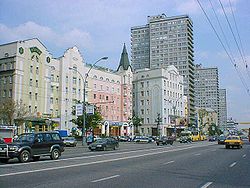
New Arbat Street
Encyclopedia

Moscow
Moscow is the capital, the most populous city, and the most populous federal subject of Russia. The city is a major political, economic, cultural, scientific, religious, financial, educational, and transportation centre of Russia and the continent...
running west from Arbat Square
Arbat Square
Arbatskaya Square of Arbat Square is one of the oldest squares of Moscow, located on the junction of Gogolevsky Boulevard, Znamenka Street and Arbat Gates Square ....
on the Boulevard Ring
Boulevard Ring
The Boulevard Ring is Moscow's second centremost ring road . Boulevards form a semicircular chain along the western, northern and eastern sides of the historical White City of Moscow; in the south the incomplete ring is terminated by the embankments of Moskva River...
to Novoarbatsky Bridge on the opposite bank of the Moskva River
Moskva River
The Moskva River is a river that flows through the Moscow and Smolensk Oblasts in Russia, and is a tributary of the Oka River.-Etymology:...
. The modern six-lane avenue (originally named Kalinin Prospekt from 1968-1994), along with two rows of high-rise buildings, was constructed between 1962 and 1968, and was literally cut through the old, narrow streets of the Arbat District. The avenue received its present name in 1990.
Within the Garden Ring
A modern avenue running parallel to the picturesque Arbat StreetArbat Street
The Arbat is an approximately one-kilometer long pedestrian street in the historical centre of Moscow. The Arbat has existed at least since the 15th century, thus laying claim to being one of the oldest surviving streets of the Russian capital. It forms the heart of the Arbat District of Moscow...
was first envisioned in Joseph Stalin
Joseph Stalin
Joseph Vissarionovich Stalin was the Premier of the Soviet Union from 6 May 1941 to 5 March 1953. He was among the Bolshevik revolutionaries who brought about the October Revolution and had held the position of first General Secretary of the Communist Party of the Soviet Union's Central Committee...
's 1935 Master Plan, however the project was delayed by the outbreak of the Second World War
World War II
World War II, or the Second World War , was a global conflict lasting from 1939 to 1945, involving most of the world's nations—including all of the great powers—eventually forming two opposing military alliances: the Allies and the Axis...
, and work did not begin until the late 1950s. The first stage of the project, the Novoarbatsky Bridge, was completed in 1957. Between 1957 and 1963, the city redeveloped land on the opposite (western) bank of the Moskva
Moskva River
The Moskva River is a river that flows through the Moscow and Smolensk Oblasts in Russia, and is a tributary of the Oka River.-Etymology:...
, creating the beginning of Kutuzovsky Prospekt
Kutuzovsky Prospekt
Kutuzovsky Prospekt is a major radial avenue in Moscow, Russia, named after Mikhail Illarionovich Kutuzov, leader of Russian field army during the French invasion of Russia...
, and completing the main part of New Arbat by 1968.
The southern side of the avenue (excluding the historical buildings of the Praga Restaurant and the Grauerman Nursery near Arbat Square) is dominated by a series of V-shaped, 26-storey office built atop a long two-storey structure housing restaurants, retail establishments and two underground levels for storage and delivery. Despite the government's public statements against gambling, more than half of this space was for a long time occupied by casinos. On July 4, 2009, a new government ban restricted gambling to four permitted zones, effectively putting an end to the industry in Moscow; the Novy Arbat casinos have subsequently either closed or morphed into entertainment centers and restaurants.
The northern side, has five narrow 26-storey apartment towers positioned perpendicularly to the avenue. The space between the towers is occupied by (west to east):
- The Oktyabr cinema
- A row of "old" office buildings, actually built in 1996 using fragments of historical structures
- A row of genuine early 20th century buildings, although these have been heavily rebuilt
- The Moscow House of Books, the city's largest bookstore. The Lermontov Memorial House stands right behind it - one of the few surviving single-story wooden houses built after the 1812 FireFire of Moscow (1812)The 1812 Fire of Moscow broke out on September 14, 1812 in Moscow on the day when Russian troops and most residents abandoned the city and Napoleon's vanguard troops entered the city following the Battle of Borodino...
.
Native Muscovites sometimes refer to the office blocks as "the dentures".
Beyond the Garden Ring
The short stretch beyond Novoarbatsky Bridge is lined with Stalinist apartment buildings; a five-story postconstructivistPostconstructivism
Postconstructivism was a transitional architectural style that existed in the Soviet Union in the 1930s, typical of early Stalinist architecture before World War II. The term postconstructivism was coined by Selim Khan-Magomedov, a historian of architecture, to describe the product of avant-garde...
block on the south side was recently torn down and replaced with luxury apartment buildings.
- The tallest building, the 31-storey ComeconComeconThe Council for Mutual Economic Assistance , 1949–1991, was an economic organisation under hegemony of Soviet Union comprising the countries of the Eastern Bloc along with a number of communist states elsewhere in the world...
tower, was completed in 1965–1970. - The grounds of the United StatesUnited StatesThe United States of America is a federal constitutional republic comprising fifty states and a federal district...
Embassy are located just north from Comecon tower - The White House, the seat of Russia's government, stands on the embankment west of the US Embassy
- The new embassy of United KingdomUnited KingdomThe United Kingdom of Great Britain and Northern IrelandIn the United Kingdom and Dependencies, other languages have been officially recognised as legitimate autochthonous languages under the European Charter for Regional or Minority Languages...
stands on the embankment south of the avenue.

